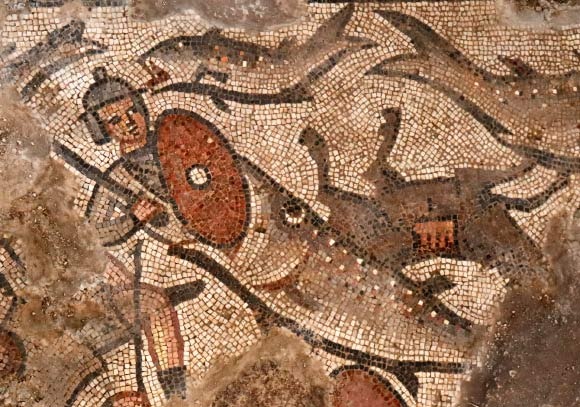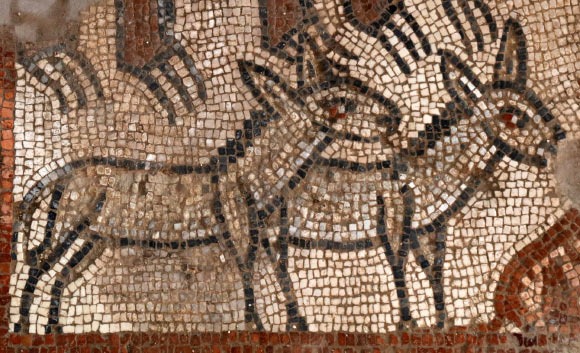Beautiful 1,500-year-old mosaics depicting Noah’s ark, animals, and the parting of the Red Sea have been discovered by archaeologists excavating a synagogue at Huqoq, an ancient Jewish village located three miles west of Magdala in the Galilee of Israel.

Mosaic of the parting of the Red Sea. Image credit: Baylor University.
Mosaic of the parting of the Red Sea. Image credit: Baylor University.
The newly-discovered mosaic panels decorate the floor of a synagogue that dates to the time when the area was ruled by the Roman Empire and when Christianity had become the Empire’s official religion.
They portray two Biblical stories: Noah’s Ark and the parting of the Red Sea.
The panel with Noah’s Ark depicts an ark and pairs of animals, including elephants, leopards, donkeys, snakes, bears, lions, ostriches, camels, sheep and goats.
The scene of the parting of the Red Sea shows Pharaoh’s soldiers being swallowed by large fish, surrounded by overturned chariots with horses and chariot drivers.
“These scenes are very rare in ancient synagogues,” said Dr. Jodi Magness from the University of North Carolina at Chapel Hill, the director of excavations at Huqoq.
“The only other examples that have been found are at Gerasa/Jerash in Jordan and Mopsuestia/Misis in Turkey (Noah’s Ark), and at Khirbet Wadi Hamam in Israel and Dura Europos in Syria (the parting of the Red Sea).”

Mosiac of Noah’s ark. Image credit: Baylor University.
Mosiac of Noah’s ark. Image credit: Baylor University.
Mosaics were first discovered at the Huqoq site in 2012, and excavations have since continued each summer.
Since then, mosaics depicting Samson and the foxes (as related in the Bible’s Judges 15:4), Samson carrying the gate of Gaza on his shoulders (Judges 16:3) and a scene containing a Hebrew inscription surrounded by human figures, animals and mythological creatures have been uncovered.
Another mosaic discovered and excavated in the synagogue’s east aisle in the 2013-2014 seasons depicts the first non-biblical story ever found decorating an ancient synagogue – perhaps the legendary meeting between Alexander the Great and the Jewish high priest.
A mosaic uncovered in 2015 next to this scene contains a Hebrew inscription surrounded by human figures, animals and mythological creatures including putti (cupids).
“This is by far the most extensive series of Biblical stories ever found decorating the mosaic floor of an ancient synagogue,” Dr. Magness said.
“The arrangement of the mosaics in panels on the floor brings to mind the synagogue at Dura Europos in Syria, where an array of Biblical stories is painted in panels on the walls.”
Dr. Magness and her colleagues have also uncovered coins spanning 2,300 years.
“The ancient coins are critical for our knowledge of the monumental synagogue and the associated village,” explained team member Dr. Nathan Elkins, from Baylor University’s College of Arts & Sciences.

Leave a Reply